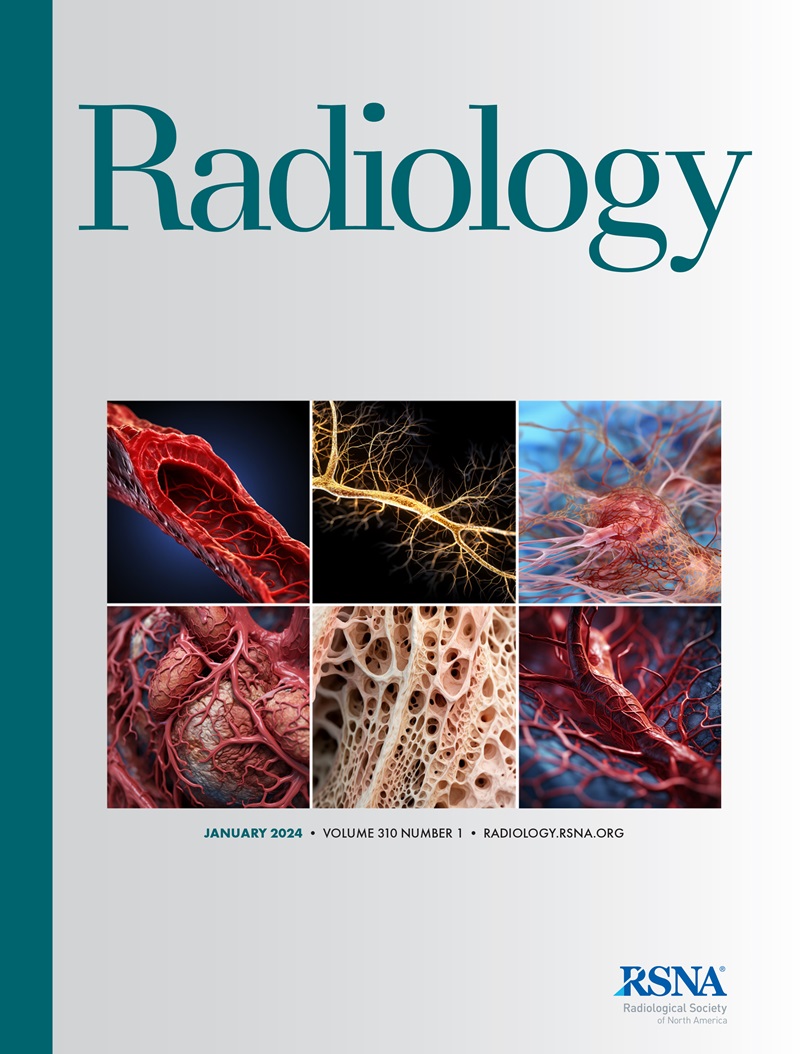Quincy A Hathaway, Arta Kasaeian, Tommy Pan, David A Bluemke, Elena Ghotbi, Joshua G Klein, Hamza Ahmed Ibad, Chris Dailing, Geoffrey H Tison, R Graham Barr, Wendy Post, Matthew Allison, João A C Lima, Matthew Budoff, Shadpour Demehri
下载PDF
{"title":"A Deep Learning Model for Three-Dimensional Determination of Whole Thoracic Vertebral Bone Mineral Density from Noncontrast Chest CT: The Multi-Ethnic Study of Atherosclerosis.","authors":"Quincy A Hathaway, Arta Kasaeian, Tommy Pan, David A Bluemke, Elena Ghotbi, Joshua G Klein, Hamza Ahmed Ibad, Chris Dailing, Geoffrey H Tison, R Graham Barr, Wendy Post, Matthew Allison, João A C Lima, Matthew Budoff, Shadpour Demehri","doi":"10.1148/radiol.242133","DOIUrl":null,"url":null,"abstract":"<p><p>Background Recent studies have investigated how deep learning (DL) algorithms applied to CT using two-dimensional (2D) segmentation (sagittal or axial planes) can calculate bone mineral density (BMD) and predict osteoporosis-related outcomes. Purpose To determine whether TotalSegmentator, an nnU-net algorithm, can measure three-dimensional (3D) vertebral body BMD across consistently imaged thoracic levels (T1-T10) at any conventional, noncontrast chest CT examination. Materials and Methods This study is a secondary analysis of a multicenter (<i>n</i> = 6) prospective cohort, the Multi-Ethnic Study of Atherosclerosis (MESA). Participants underwent noncontrast chest CT with (<i>n</i> = 296) and without (<i>n</i> = 2660) a phantom. In 594 participants, manual segmentation for T1-T10 vertebrae was performed on axial and sagittal planes. TotalSegmentator provided 3D vertebral body segmentation of T1-T10 levels with further postprocessing to remove cortical bone. Two-dimensional axial and sagittal DL-derived algorithms were developed and compared with 3D model performance. Dice and intersection-over-union scores were calculated. Vertebral BMD-derived data, integrated with the Fracture Risk Assessment Tool with no BMD (FRAXnb), were used to predict incident vertebral fractures (VFx) in participants from the follow-up MESA Examination 6 (<i>n</i> = 1304). Results This study included 2956 participants (1546 [52%] female; age, 69 years ± 9 [SD]), with longitudinal data obtained approximately 6.2 years later in a subset of 1304 participants. DL-derived 3D segmentations were correlated with manual axial (Dice score, 0.93; 95% CI: 0.92, 0.95) and sagittal (Dice score, 0.91; 95% CI: 0.88, 0.93) segmentations. DL-derived 2D axial and sagittal BMD measurements had higher uncertainty compared with DL-derived 3D BMD measurements (average SDs, 2D axial and 2D sagittal vs 3D BMD: 65 mg/cm<sup>3</sup> and 59 mg/cm<sup>3</sup> vs 41 mg/cm<sup>3</sup>, respectively; both <i>P</i> < .001). Three-dimensional vertebral BMD with FRAXnb demonstrated better performance in predicting incident VFx (area under the receiver operating characteristic curve [AUC], 0.82) compared with FRAXnb alone (AUC, 0.66; <i>P</i> = .03). Conclusion A multilevel DL algorithm for measuring 3D whole thoracic vertebral BMD using conventional chest CT determined distinct BMD patterns from whole thoracic vertebrae and provided incremental value in predicting VFx. ClinicalTrials.gov identifier: NCT00005487 © RSNA, 2025 <i>Supplemental material is available for this article</i>. See also the editorial by Steiger in this issue.</p>","PeriodicalId":20896,"journal":{"name":"Radiology","volume":"314 3","pages":"e242133"},"PeriodicalIF":12.1000,"publicationDate":"2025-03-01","publicationTypes":"Journal Article","fieldsOfStudy":null,"isOpenAccess":false,"openAccessPdf":"https://www.ncbi.nlm.nih.gov/pmc/articles/PMC11950887/pdf/","citationCount":"0","resultStr":null,"platform":"Semanticscholar","paperid":null,"PeriodicalName":"Radiology","FirstCategoryId":"3","ListUrlMain":"https://doi.org/10.1148/radiol.242133","RegionNum":1,"RegionCategory":"医学","ArticlePicture":[],"TitleCN":null,"AbstractTextCN":null,"PMCID":null,"EPubDate":"","PubModel":"","JCR":"Q1","JCRName":"RADIOLOGY, NUCLEAR MEDICINE & MEDICAL IMAGING","Score":null,"Total":0}
引用次数: 0
引用
批量引用
Abstract
Background Recent studies have investigated how deep learning (DL) algorithms applied to CT using two-dimensional (2D) segmentation (sagittal or axial planes) can calculate bone mineral density (BMD) and predict osteoporosis-related outcomes. Purpose To determine whether TotalSegmentator, an nnU-net algorithm, can measure three-dimensional (3D) vertebral body BMD across consistently imaged thoracic levels (T1-T10) at any conventional, noncontrast chest CT examination. Materials and Methods This study is a secondary analysis of a multicenter (n = 6) prospective cohort, the Multi-Ethnic Study of Atherosclerosis (MESA). Participants underwent noncontrast chest CT with (n = 296) and without (n = 2660) a phantom. In 594 participants, manual segmentation for T1-T10 vertebrae was performed on axial and sagittal planes. TotalSegmentator provided 3D vertebral body segmentation of T1-T10 levels with further postprocessing to remove cortical bone. Two-dimensional axial and sagittal DL-derived algorithms were developed and compared with 3D model performance. Dice and intersection-over-union scores were calculated. Vertebral BMD-derived data, integrated with the Fracture Risk Assessment Tool with no BMD (FRAXnb), were used to predict incident vertebral fractures (VFx) in participants from the follow-up MESA Examination 6 (n = 1304). Results This study included 2956 participants (1546 [52%] female; age, 69 years ± 9 [SD]), with longitudinal data obtained approximately 6.2 years later in a subset of 1304 participants. DL-derived 3D segmentations were correlated with manual axial (Dice score, 0.93; 95% CI: 0.92, 0.95) and sagittal (Dice score, 0.91; 95% CI: 0.88, 0.93) segmentations. DL-derived 2D axial and sagittal BMD measurements had higher uncertainty compared with DL-derived 3D BMD measurements (average SDs, 2D axial and 2D sagittal vs 3D BMD: 65 mg/cm3 and 59 mg/cm3 vs 41 mg/cm3 , respectively; both P < .001). Three-dimensional vertebral BMD with FRAXnb demonstrated better performance in predicting incident VFx (area under the receiver operating characteristic curve [AUC], 0.82) compared with FRAXnb alone (AUC, 0.66; P = .03). Conclusion A multilevel DL algorithm for measuring 3D whole thoracic vertebral BMD using conventional chest CT determined distinct BMD patterns from whole thoracic vertebrae and provided incremental value in predicting VFx. ClinicalTrials.gov identifier: NCT00005487 © RSNA, 2025 Supplemental material is available for this article . See also the editorial by Steiger in this issue.

 求助内容:
求助内容: 应助结果提醒方式:
应助结果提醒方式:


